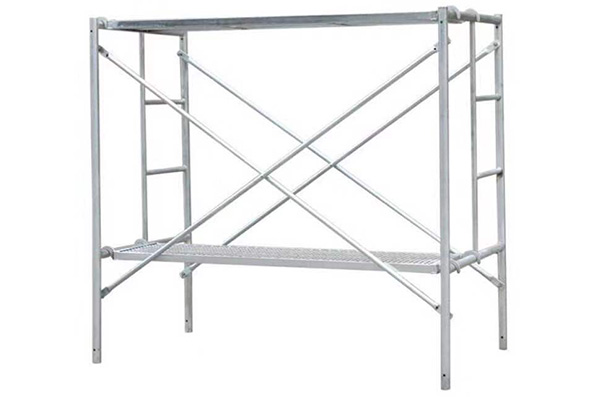What is Frame Scaffolding?
Frame scaffolding is one of the most commonly used types of scaffolding systems in the construction industry. Known for its simplicity, efficiency, and versatility, frame scaffolding provides a reliable platform for workers to perform tasks at elevated heights. In this article, we’ll explore what frame scaffolding is, its key components, advantages, and common applications.

What is Frame Scaffolding?
Frame scaffolding is a temporary structure made of steel or aluminum tubes. It consists of modular rectangular frames that are connected to create a stable platform for construction work. These systems are particularly popular in residential, commercial, and industrial projects due to their ease of assembly and adaptability to different project requirements.
Key Components of Frame Scaffolding
A typical frame scaffolding system includes the following essential components:
- Frames: These are the vertical sections, often rectangular or square in shape, that provide the main structural support.
- Cross Braces: Diagonal components that stabilize the frames and ensure the structure’s rigidity.
- Planks/Platforms: Horizontal boards or panels where workers stand and place tools or materials.
- Base Jacks: Adjustable feet that help level the scaffold on uneven ground.
- Guardrails and Toeboards: Safety features that prevent falls and material displacement.

Types of Frame Scaffolding
Frame scaffolding is available in several designs to suit diverse construction applications. Here’s an overview of the most commonly used types:
1. Walk-Through Frames
Walk-through frames, also known as arch frames, are designed to provide an open passageway beneath the scaffold. This type is ideal for masonry and facade work where workers or materials need to move freely at ground level. Its open structure minimizes obstructions, making it a popular choice for large-scale projects.
2. Ladder Frames
Ladder frames incorporate a built-in ladder on one side, allowing workers to easily climb between different scaffold levels. This design is particularly useful for projects that require frequent vertical movement, such as multi-story building construction. Ladder frames are both space-efficient and functional.
3. Mason Frame Scaffolding
Mason frame scaffolding is specifically designed for masonry applications, such as bricklaying, plastering, and facade work. These frames typically feature wide openings to provide ample workspace for handling bricks, mortar, and other materials. They are highly stable and can support heavy loads, making them ideal for use in low- to mid-rise building projects. Mason frame scaffolding is easy to assemble and disassemble, which helps streamline construction workflows while maintaining worker safety.
4. Double or Box Frames
Double frames, also referred to as box frames, are designed for projects that require extra stability and high load capacities. These frames have a robust structure, making them suitable for heavy-duty tasks like supporting large materials or working in industrial settings.

Advantages of Frame Scaffolding
Frame scaffolding offers numerous benefits, making it a preferred choice for many contractors:
- Ease of Installation: The modular design allows for quick and straightforward assembly, reducing labor time.
- Versatility: Suitable for a wide range of projects, from residential to industrial.
- Cost-Effectiveness: Reusable components lower long-term costs.
- Durability: Made from high-strength materials that withstand heavy loads and harsh environments.
- Accessibility: Provides easy access to hard-to-reach areas, improving efficiency and safety.
Applications of Frame Scaffolding
Frame scaffolding is widely used across various industries:
- Construction: Building walls, facades, and ceilings.
- Painting and Plastering: Providing a stable platform for surface treatments.
- Maintenance and Repairs: Facilitating work on bridges, buildings, and other structures.
- Events: Supporting lighting, stages, and temporary structures.

How to Choose the Right Frame Scaffolding
When selecting frame scaffolding, consider the following factors:
- Height Requirements: Ensure the system can safely reach the required working height.
- Load Capacity: Check that it can support the weight of workers, tools, and materials.
- Certification and Standards: Always use scaffolding systems that meet industry safety standards, such as OSHA or EN standards.
- Environment: Opt for corrosion-resistant materials if the project is in a humid or coastal area.
FAQs
Frame scaffolding is typically made of high-strength steel or aluminum. Steel frames are known for their durability and load-bearing capacity, while aluminum frames are lightweight and corrosion-resistant.
The maximum height of frame scaffolding depends on the design, material, and safety regulations in your area. Generally, it can be safely erected to heights of up to 30 meters (98 feet) or more with proper bracing and anchoring.
Yes, frame scaffolding is designed for reuse. With proper care, maintenance, and storage, it can be used for multiple projects, making it a cost-effective choice for construction companies.
Absolutely! Frame scaffolding is versatile and can be used for both indoor and outdoor projects, including painting, ceiling repairs, and maintenance work.
Safety measures include ensuring the scaffold is properly leveled, using guardrails and toeboards, regularly inspecting the structure for defects, and providing workers with appropriate personal protective equipment (PPE) like harnesses and helmets.
Frame scaffolding is modular and easy to assemble, making it more convenient than traditional bamboo or wooden scaffolding. It is also more stable and durable than mobile scaffolding and less complex to erect compared to ringlock or cuplock systems.
Conclusion
Frame scaffolding is an indispensable tool in construction and maintenance projects, providing a reliable, adaptable, and cost-effective solution for various tasks. Its simple design and robust performance make it a favorite among contractors and builders worldwide.
Need high-quality frame scaffolding for your next project? Contact us today for durable, certified products designed to meet your specific needs!
